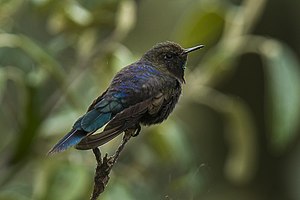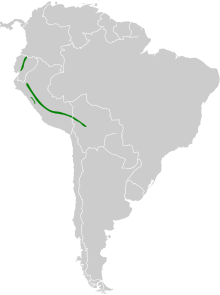Schwarzkopf glossy tail
| Schwarzkopf glossy tail | ||||||||||
|---|---|---|---|---|---|---|---|---|---|---|

Schwarzkopf glossy tail |
||||||||||
| Systematics | ||||||||||
|
||||||||||
| Scientific name | ||||||||||
| Chalcostigma stanleyi | ||||||||||
| ( Bourcier , 1851) |
The black-headed glossy tail ( Chalcostigma stanleyi ), sometimes also called blue-backed glossy tail , is a species of bird in the hummingbird family (Trochilidae). The species has a large range that includes the South American countries Ecuador , Peru and Bolivia . The IUCN assesses the population as Least Concern .
features
The Schwarzkopf gloss tail reaches a body length of about 12 to 13 cm, with the short beak being 1.2 cm long. The male is predominantly sooty brown, almost black on the face and sides of the neck, and with a purple-blue sheen on the back. The approximately 4.6 cm long, strongly forked tail is steel blue. The elongated and pointed throat patch glitters green and becomes glistening purple at the lower end. The females are very similar, but have a shorter tail, less black sheen on the back and no glittering throat patch, instead they are whitish there with bronze-colored speckles. Juveniles are completely black on the underside and only rarely have small, mouse-gray spots.
behavior
Occasionally they can be seen walking on slopes and rocks while foraging. Most of the time, however, they collect nectar by clinging to flowers and often flapping their wings. They prefer sugary secretions and small cicadas and aphids , which they collect from the underside of Gynoxys leaves. They fight aggressively with birds of the genus Dacnis , which share the same food sources. Occasionally they cling or fly to small flowers such as B. barberries , mock berries , currants and small red gentians .
Vocalizations
Your call sounds like a weak tsir sound.
distribution and habitat
They prefer slopes with relatively humid páramo and suni vegetation . Here they occur especially in steep rocky areas with Gynoxys- Polylepis trees or bushes and replace the white-tipped glossy tail ( Chalcostigma herrani ) at altitudes between 3700 and 4400 meters . You can find them in the Páramo areas in the north of Ecuador up to possibly even in the Departamento de Nariño in Colombia . In the province of Azuay , they are common in the mountains of the Cajas National Park . They can be found scattered in the central Andes of La Libertad and Amazonas in Peru. In the western Andes they are partly present in Cajamarca , Junín , Pasco and Mamacocha in the Ayacucho region . In the east they occur from Ocobamba in the Cusco region to the mountainous regions of the Tunari National Park in the Cochabamba department .
Subspecies
There are three known subspecies:
- Chalcostigma stanleyi stanleyi ( Bourcier , 1851) - The nominate form occurs in Ecuador.
- Chalcostigma stanleyi versigulare Zimmer, JT , 1924 - This subspecies is common in northern Peru.
- Chalcostigma stanleyi vulcani ( Gould , 1852) - This subspecies occurs in southern Peru to western central Bolivia.
Etymology and history of research
Jules Bourcier described the black-headed glossy tail under the name Trochilus Stanleyi . As a distribution area, he named the provinces of Pichincha and Cotopaxi . In 1854 Heinrich Gottlieb Ludwig Reichenbach introduced the new genus Chalcostigma , to which he also assigned the Schwarzkopf glossy tail. This name is derived from the Greek words "chalkos χαλκός " for "bronze, bronze-colored" and "stigma στίγμα " for "feature, marking". The species name stanleyi is dedicated to Edward Henry Stanley, 15th Earl of Derby (1826-1893). Versigulare is derived from the Latin words versi-, vertere for 'changing, changing' and gularis, gula for '-throat, throat'. Vulcani is derived from the Latin word vulcanius for 'volcanic' and thus from the Roman god of fire Vulcanus .
literature
- Jon Fjeldså , Niels Krabbe : Birds of the High Andes: A Manual to the Birds of the Temperate Zone of the Andes and Patagonia, South America . Apollo Books, Stenstrup 1990, ISBN 978-87-88757-16-3 .
- James A. Jobling: Helm Dictionary of Scientific Bird Names . Christopher Helm, London 2010, ISBN 978-1-4081-2501-4 .
- Jules Bourcier: Note on our espèces de trochilidées . In: Comptes rendus hebdomadaires des séances de l'Académie des sciences . tape 32 , 1851, pp. 186-188 ( biodiversitylibrary.org ).
- John Todd Zimmer : New Birds from Central Peru . In: Field Museum Natural History Publications (= Zoological Series ). tape 12 , no. 4 , 1924, pp. 49-67 ( biodiversitylibrary.org ).
- John Gould in William Jardine, 7th Baronet of Applegarth: Description of three new species of Humming-Birds . In: Contributions to Ornithology . tape 6 . Samuel Highley, London 1852, p. 135–137 ( reader.digitale-sammlungen.de ).
- Heinrich Gottlieb Ludwig Reichenbach: Enumeration of the hummingbirds or trochilids in their true natural relationship, including the key to their systematics . In: Journal of Ornithology . tape 2 (separate issue), 1854, p. 1-24 ( biodiversitylibrary.org ).
- Étienne Mulsant, Édouard Verreaux: Histoire naturelle des oiseaux-mouches ou colibris constituant la famille des trochilidés . tape 3 . Deyrolle, Paris 1877 ( online ).
Web links
- Chalcostigma stanleyi inthe IUCN Red List of Threatened Species 2016.1. Listed by: BirdLife International, 2012. Retrieved September 4, 2016.
- BirdLife International: Species Factsheet - Blue-mantled Thornbill ( Chalcostigma stanleyi ) . Retrieved September 4, 2016.
- Videos, photos and sound recordings of Blue-mantled Thornbill (Chalcostigma stanleyi) in the Internet Bird Collection
- Schwarzkopf glosstail ( Chalcostigma stanleyi ) at Avibase; accessed on September 4, 2016.
- Chalcostigma stanleyi in the Integrated Taxonomic Information System (ITIS)
- xeno-canto: Sound recordings - Blue-mantled Thornbill ( Chalcostigma stanleyi )
Individual evidence
- ↑ a b c d Jon Fjeldså u. a., p. 287.
- ^ IOC World Bird List Hummingbirds
- ↑ a b Jules Bourcier, p. 187.
- ↑ John Todd Zimmer, p. 52.
- ^ John Gould, p. 135.
- ↑ Heinrich Gottlieb Ludwig Reichenbach, p. 12.
- ↑ James A. Jobling p. 98.
- ↑ Étienne Mulsant et al. a., p. 166.
- ↑ James A. Jobling, p. 400.
- ↑ James A. Jobling, p. 404.
Remarks
- ↑ He categorized the bronze-tailed thornbill ( Chalcostigma Heteropogon ( Boissonneau , 1840)), the rainbow-bearded thornbill ( Chalcostigma herrani ( Delattre & Bourcier , 1846)), the chestnut cap Glanzschwänzchen ( Chalcostigma ruficeps ( Gould , 1846)) and Chalcostigma stanleyi Vulcani in of the new genus.

